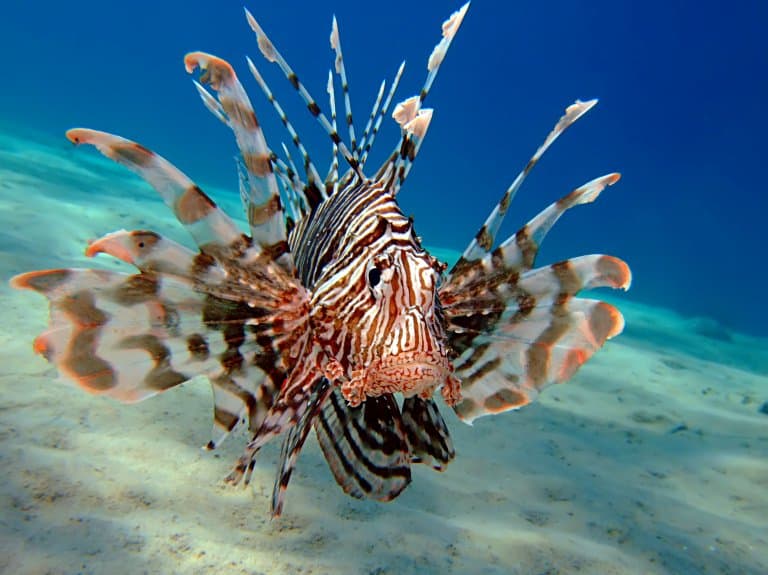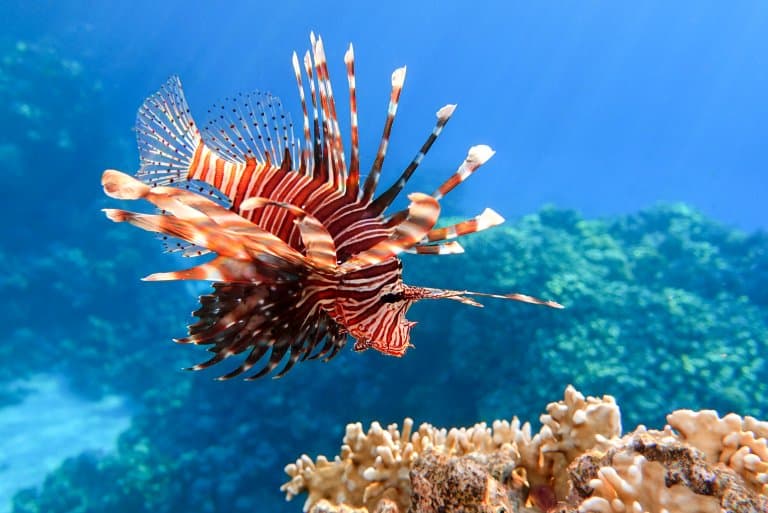Lionfish Profile
Lionfish are a group of fish known for their maroon, white or black stripes, intricate fins, and venomous spiky extensions. They have also been called turkeyfish, firefish and tastyfish.
They inhabit coral reefs of the Pacific Ocean, as well as the Indian Ocean, and are capable of adapting to a wide range of environments that vary in temperature and depth.

Lionfish Facts Overview
| Habitat: | Shallow reefs, lagoons, coastal waters |
| Location: | South Pacific Ocean, Indian Ocean |
| Lifespan: | Up to 15 years in the wild |
| Size: | 12 to 15 inches in length |
| Weight: | Up to 3 pounds |
| Color: | Maroon (sometimes brown) and white stripes |
| Diet: | Small marine fish, shrimp, mollusks, and other lionfish |
| Predators: | Unknown |
| Top Speed: | Unknown |
| No. of Species: |
12 |
| Conservation Status: |
Least concern |
There are 12 species of Lionfish, and 2 species, the red lionfish and the common lionfish are currently classified as invasive species.
Like many other fish, the lionfish congregates in groups called schools. They prefer to live in rocky habitats that allow them to camouflage with ease.
Lionfish diet on small fish, invertebrates, and mollusks and have few natural predators due to the potential threat of their venomous spikes.
The lionfish is edible, and it has been said that they are quite delicious. However, due to their venomous spines, they need to be processed with care prior to being consumed.
In captivity, this marine fish is commonly found in aquariums around the world.
Interesting Lionfish Facts
1. Their dorsal fins are venomous
The 13 long fins that extend from the spine of the lionfish are venomous and used to deter predators
To humans, a lionfish sting is extremely painful and can bring about severe nausea and impair breathing. Fortunately, while unpleasant, injuries are rarely fatal.
Lionfish are venomous, not poisonous. Poisonous animals release their toxins when they are ingested, whereas venomous creatures apply their toxins via a bite or a sting. 1
2. They were so named because of their appearance
The fan-like arrangement of their long dorsal fins and spindly pectoral fins resembles that of a lion’s mane. Hence the name, lionfish! 2

3. They are fierce predators
Lionfish have been documented to hunt over 50 species of fish. They will corner prey and strike, engulfing their meals in a swift bite.
Because of their voracious appetite and invasive patterns, there is growing concern over their impact on many tropical habitats around the globe.

4. To accommodate their large appetites, they have enormous stomach capacities
A lionfish’s stomach can expand up to 30 times its regular size. Gobies, snappers, and groupers are some of its favorites. 3
5. Their scales have a unique shape
Lionfish have cycloid scales that are thin and oval-shaped with smooth edges.
Other fish, such as trout and carp, also have scales like this.

6. Lionfish venom contains a potent mixture of neurotoxins and neurotransmitters
After being punctured by a venomous spine, the acetylcholine (a neurotransmitter) present in lionfish venom causes changes in heart rate, muscle spasms, and dizziness.
If you find yourself being stung, seek medical attention straight away.
7. They are ravenous carnivores
Lionfish will eat pretty much anything they can get their mouths on.
When prey is lacking, they have also been found eating members of their own species.
8. Males avidly defend their territory
Lionfish are territorial and will fervently contest others to protect their space. Males are particularly aggressive, frequently fighting other males by charging and aiming their spines at their opponents.
9. Females lay thousands of eggs at a time
A collection of lionfish eggs is called a clutch. A single clutch can contain between 2,000 to 15,000 eggs.
Females will lay their clutches into the water before a male fertilizes them.
10. They require over a year to mature
In the wild, lionfish can survive for up to 15 years. After hatching, they take approximately 18 months to reach full maturity.
11. They usually hunt at night
Lionfish are believed to be nocturnal creatures, preferring to hunt at night.

12. Little is known about their natural predators
Few dare to attack lionfish for fear of being pierced by their thorny fins. Research suggests some fish would rather go without any food than eat a lionfish.
13. Females can reproduce year-round
Laying thousands of eggs each time, female lionfish can produce up to 2 million eggs per year. This further adds to their capacity as an invasive species.
14. There are competitions held to control lionfish populations
Competitions, termed derbies, are held in areas where populations are especially overwhelming.
Contestants are recognized based on how many lionfish they can catch within a specified length of time!

15. Their expansion is truly unprecedented
To many marine biologists, the rate at which lionfish numbers have grown is astounding.
In just a few years, certain regions have witnessed lionfish numbers jump from nonexistent to downright intrusive. 4
Lionfish Fact-File Summary
Scientific Classification
| Kingdom: | Animalia |
| Phylum: | Chordata |
| Class: | Actinopterygii |
| Order: | Scorpaeniformes |
| Family: | Scorpaenidae |
| Tribe: | Pteroini |
| Genus: |
Pterois |
| Species Names: |
Pterois andover (Andover lionfish) Pterois antennata (Spot-fin lionfish) Pterois brevipectoralis Pterois cincta (Red Sea lionfish) Pterois lunulata (Luna lionfish) Pterois miles (Devil firefish) Pterois mombasae (African lionfish, frill-fin turkeyfish) Pterois paucispinula Pterois radiata (Clear-fin lionfish) Pterois russelii (Plaintail turkeyfish, soldier lionfish, or Russell’s lionfish) Pterois sphex (Hawaiian turkeyfish) Pterois volitans (Red lionfish) |
Fact Sources & References
- “Red Lionfish”. National Geographic.
- “What is a lionfish?”. National Ocean Service.
- Gupta, Anika. “Invasion of the Lionfish”. Smithsonian Magazine.
- Lanese, Nicoletta. “Lionfish: Beautiful and Dangerous Invaders”. Live Science.
